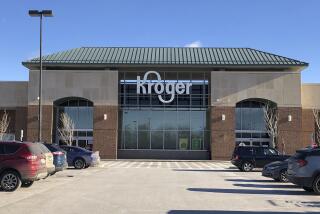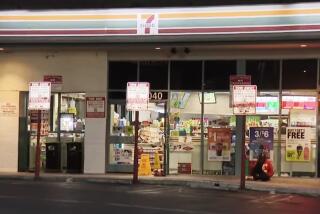Much Was in Store for 2 Family Enterprises
- Share via
Two of Southern California’s leading “supermarkets” -- a term that caught on nationwide -- started out as two little family-owned grocery stores.
Ralphs and Vons are part of huge corporations today with tens of thousands of workers and front-page labor troubles. But they brought their founding families a measure of regional immortality.
George Albert Ralphs -- with an S and without an apostrophe -- was born in Joplin, Mo., in 1850. As a baby, he embarked on a grueling 18-month journey with his devout Mormon parents, Richard and Mary Ralphs, across the plains to Salt Lake City and the fledgling Mormon community of San Bernardino.
In 1851, they joined more than 400 pioneers on an arduous trek across the desert. Brigham Young, president of the Church of Jesus Christ of Latter-day Saints, sent colonists to establish an outpost to serve as a major link in the church’s supply line between San Pedro’s harbor and Salt Lake.
While crossing the Mojave Desert, the parched children cried out for water. Richard Ralphs found their delirious wails worse to bear than his own killing thirst. With swollen tongues, he and some of the others went looking for a water hole.
They found what they were looking for, but not quite where they had hoped.
“When the horses started to urinate, someone grabbed a coffee pot and caught the urine,” said Walter Ralphs, George’s great-nephew. “They took it back to camp, boiled it and drank it. It saved their lives.”
Finally, the travelers reached their destination. Settling at the base of the Cajon Pass, Richard Ralphs, an English immigrant and potter by trade, set up San Bernardino’s first brick factory. In 1857, when San Bernardino colonists were recalled to Utah, Ralphs stayed, as did several hundred others.
Young Ralphs grew up on the family’s 400-acre ranch in San Bernardino and, as a teenager, apprenticed with his father as a bricklayer. He became so good that he won the title Champion Bricklayer of California.
But in 1872, when he was 22, his career took a twist. Ralphs was traveling in his horse-drawn wagon with his younger brother, Walter, out of downtown Los Angeles to do a little hunting in the San Fernando Valley.
“They shot game and sold it to local butchers: Dove and quail went for two for 15 cents, while cottontail rabbit and ducks went three for 25 cents,” said Walter Ralphs, the great-nephew.
“George was driving and resting his left arm on the barrel of his shotgun when the wagon hit a deep hole,” the great-nephew said. “The shotgun went off, wounding his left arm.” It took hours to travel back to town. By the time George got medical treatment, a doctor had to amputate his arm at the elbow.
Ralphs turned to clerking in a small grocery at 5th and Spring streets that was owned by a man known to history only as Francis. Within a year, Ralphs had parlayed his earnings into a partnership with his boss at a second store, at 6th and Spring.
Walter Ralphs joined his elder brother in the business in the mid-1870s. They bought Francis’ interest in the 6th and Spring store for about $2,000 and changed the name to Ralphs Bros. Grocers. The store remained at the site until 1901, when it moved a few doors away on Spring. That allowed construction of the Hayward Hotel, which still stands.
Seeking an imaginative way to tap the rich market of Los Angeles, the brothers came up with a daring and innovative concept. By providing free lodging and stables for farmers bringing their crops to market, the Ralphses could lock up huge supplies and offer customers lower prices than their competitors.
By the 1890s, business was booming, and they added free home delivery. But by then George was a widower and drinking heavily. Walter went into real estate, selling his share to another brother, Oscar Newell Ralphs, also a widower.
George and Newell, as he was known, became drinking buddies, and the business began to slide. Brother Walter believed George was a bad influence on Newell and wanted to get Newell as far away from downtown Los Angeles as possible.
That’s when Walter began buying up land from the Tehachapis south into Mexico, including virtually the entire rustic town of Gorman and nearly 3,000 surrounding acres. He put Newell in charge of managing the land, then deeded it to him, according to Walter.
In 1896, George pulled himself together when he met and married Wallula Von Keith, a strict Christian Scientist. Again, the business boomed.
By 1907, Ralphs grocers had expanded to non-food items. Customers could order anything from oil stoves to sadirons -- heavy clothes irons.
The business was incorporated as Ralphs Grocery Co. in 1909, with the family retaining all the stock.
Ralphs’ main competitor was already in business just a few blocks away.
Danish immigrant Charles T. Von der Ahe had moved from Copenhagen to Los Angeles with $1,200 in his pocket. In 1906, he opened his first Vons Groceteria, a 20-foot-wide neighborhood store at 7th and Figueroa streets.
By 1928, he had expanded his idea for a “cash and carry” business -- an alternative to the “charge and deliver” system -- to a chain of 87 stores, which he sold a year later.
But in 1932, despite the Depression, he gave sons Wilfred and Theodore the financial backing to restart Vons Grocery Co. Soon, they offered a bakery, a deli, and meat, grocery and produce departments under the same roof, becoming known as a “supermarket.”
The Von der Ahes were devout Catholics, lauded by the Vatican for their charitable work. They were also power brokers who presided over the finest country clubs and buildings.
Ralphs and Vons were fierce competitors that learned from and tried to top each other.
But it was George Ralphs who first understood what the automobile would mean to the grocery business. In 1911, he built an offshoot of his original store at Pico Boulevard and Normandie Avenue. That was the first step in what would become today’s Compton-based chain, with stores on major thoroughfares.
Ralphs loved the outdoors almost as much as he loved his business. On June 21, 1914, he, his wife and two children were on an outing at Lake Arrowhead when a 3-ton boulder dislodged and crushed his leg.
“Whatever you do, don’t give me any ether,” Ralphs, 63, told the doctor as he was carried into the hospital, according to Linda Ralphs, his great-granddaughter. “They cut off my arm without ether. You can cut off my leg the same way.”
The doctor ignored him, telling Ralphs’ teenage son, Albert George: “Your father will take to ether like a baby takes to candy.” Ralphs fought as the doctor put the anesthesia mask over his face but soon slipped into unconsciousness.
“He never woke up,” Walter said.
Ralphs’ nephews, his only son and, later, his grandsons took over the supermarkets. They continued to expand, opening more stores and adding another innovation: parking lots.
In 1926, house-brand bread began to rise and roll off assembly lines. Ralphs opened a bakery in West Los Angeles as a response to the “bread trust,” a would-be baking monopoly that threatened to double the cost of bread from 5 cents to 10 cents. In 1957, the bakery moved to bigger facilities on San Fernando Road near Glendale, where it remains today.
Ralphs’ campaign to lower the price of milk in the 1930s was less successful. The Ralphses carried their challenge to the state’s milk-pricing system all the way to the Supreme Court and lost.
The ruling led the company to build its own creamery. Being able to control the flow of goods from its manufacturing plants to the checkout counter gave Ralphs an edge in cost-saving and efficiency.
By 1928, Ralphs had opened nearly a dozen markets. It halted home delivery service and switched to the “cash and carry” system pioneered by Vons.
Ralphs was sold to Federated Department Stores in 1967 and has changed hands several times. In the last decade, mergers and consolidations have combined Ralphs, Boys, Viva, Food 4 Less and others under Kroger Co., the nation’s largest supermarket operator. There are 300 Ralphs stores.
The Von der Ahes sold the chain in 1969 but remained involved in the business until 1975. Today, Vons stores stretch from San Diego to Fresno and from Nevada to the Pacific. The chain, part of the Safeway group, has 325 sites, including Pavilions.
Volume buying, the big store, the open refrigerated case, centralized meat-cutting, the cent-off food coupon -- all came out of Southern California in the days when Von der Ahe and Ralphs were trying to cut each other’s throats.
More to Read
Inside the business of entertainment
The Wide Shot brings you news, analysis and insights on everything from streaming wars to production — and what it all means for the future.
You may occasionally receive promotional content from the Los Angeles Times.










